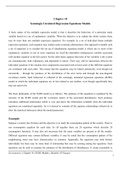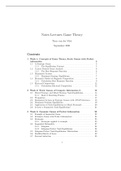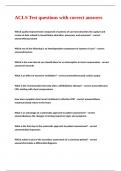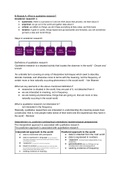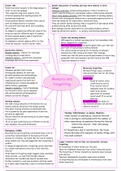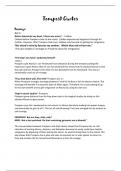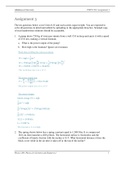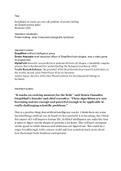Chapter 18
Seemingly Unrelated Regression Equations Models
A basic nature of the multiple regression model is that it describes the behaviour of a particular study
variable based on a set of explanatory variables. When the objective is to explain the whole system, there
may be more than one multiple regression equations. For example, in a set of individual linear multiple
regression equations, each equation may explain some economic phenomenon. One approach to handle such
a set of equations is to consider the set up of simultaneous equations model is which one or more of the
explanatory variables in one or more equations are itself the dependent (endogenous) variable associated
with another equation in the full system. On the other hand, suppose that none of the variables is the system
are simultaneously both explanatory and dependent in nature. There may still be interactions between the
individual equations if the random error components associated with at least some of the different equations
are correlated with each other. This means that the equations may be linked statistically, even though not
structurally – through the jointness of the distribution of the error terms and through the non-diagonal
covariance matrix. Such behaviour is reflected in the seemingly unrelated regression equations (SURE)
model in which the individual equations are in fact related to one another, even though superficially they
may not seem to be.
The basic philosophy of the SURE model is as follows. The jointness of the equations is explained by the
structure of the SURE model and the covariance matrix of the associated disturbances. Such jointness
introduces additional information which is over and above the information available when the individual
equations are considered separately. So it is desired to consider all the separate relationships collectively to
draw the statistical inferences about the model parameters.
Example:
Suppose a country has 20 states and the objective is to study the consumption pattern of the country. There is
one consumption equation for each state. So all together there are 20 equations which describe 20
consumption functions. It may also not necessary that the same variables are present in all the models.
Different equations may contain different variables. It may be noted that the consumption pattern of the
neighbouring states may have characteristics in common. Apparently, the equations may look distinct
individually but there may be some kind of relationship that may be existing among the equations. Such
equations can be used to examine the jointness of the distribution of disturbances. It seems reasonable to
Econometrics | Chapter 18 | SURE Models | Shalabh, IIT Kanpur
1
, assume that the error terms associated with the equations may be contemporaneously correlated. The
equations are apparently or “seemingly” unrelated regressions rather than independent relationships.
Model:
We consider here a model comprising of M multiple regression equations of the form
ki
yti xtij ij ti , t 1, 2,..., T ; i 1, 2,..., M ; j 1, 2,..., ki
j 1
where yti is the t th observation on the i th dependent variable which is to be explained by the i th regression
equation, xtij is the t th observation on j th explanatory variable appearing in the i th equation, ij is the
coefficient associated with xtij at each observation and ti is the t th value of the random error component
associated with i th equation of the model.
These M equations can be compactly expressed as
yi X i i i , i 1, 2,..., M
where yi is T 1 vector with elements yti ; X i is T K i matrix whose columns represent the T
observations on an explanatory variable in the i th equation; i is a ki 1 vector with elements ij ; and i
is a T 1 vector of disturbances. These M equations can be further expressed as
y1 X1 0 0 1 1
y2 0 X2 0 2 2
yM 0 0 X M M M
or y X
where the orders of y is TM 1 , X is TM k * , is k * 1 , is TM 1 and k * ki .
i
Econometrics | Chapter 18 | SURE Models | Shalabh, IIT Kanpur
2
Seemingly Unrelated Regression Equations Models
A basic nature of the multiple regression model is that it describes the behaviour of a particular study
variable based on a set of explanatory variables. When the objective is to explain the whole system, there
may be more than one multiple regression equations. For example, in a set of individual linear multiple
regression equations, each equation may explain some economic phenomenon. One approach to handle such
a set of equations is to consider the set up of simultaneous equations model is which one or more of the
explanatory variables in one or more equations are itself the dependent (endogenous) variable associated
with another equation in the full system. On the other hand, suppose that none of the variables is the system
are simultaneously both explanatory and dependent in nature. There may still be interactions between the
individual equations if the random error components associated with at least some of the different equations
are correlated with each other. This means that the equations may be linked statistically, even though not
structurally – through the jointness of the distribution of the error terms and through the non-diagonal
covariance matrix. Such behaviour is reflected in the seemingly unrelated regression equations (SURE)
model in which the individual equations are in fact related to one another, even though superficially they
may not seem to be.
The basic philosophy of the SURE model is as follows. The jointness of the equations is explained by the
structure of the SURE model and the covariance matrix of the associated disturbances. Such jointness
introduces additional information which is over and above the information available when the individual
equations are considered separately. So it is desired to consider all the separate relationships collectively to
draw the statistical inferences about the model parameters.
Example:
Suppose a country has 20 states and the objective is to study the consumption pattern of the country. There is
one consumption equation for each state. So all together there are 20 equations which describe 20
consumption functions. It may also not necessary that the same variables are present in all the models.
Different equations may contain different variables. It may be noted that the consumption pattern of the
neighbouring states may have characteristics in common. Apparently, the equations may look distinct
individually but there may be some kind of relationship that may be existing among the equations. Such
equations can be used to examine the jointness of the distribution of disturbances. It seems reasonable to
Econometrics | Chapter 18 | SURE Models | Shalabh, IIT Kanpur
1
, assume that the error terms associated with the equations may be contemporaneously correlated. The
equations are apparently or “seemingly” unrelated regressions rather than independent relationships.
Model:
We consider here a model comprising of M multiple regression equations of the form
ki
yti xtij ij ti , t 1, 2,..., T ; i 1, 2,..., M ; j 1, 2,..., ki
j 1
where yti is the t th observation on the i th dependent variable which is to be explained by the i th regression
equation, xtij is the t th observation on j th explanatory variable appearing in the i th equation, ij is the
coefficient associated with xtij at each observation and ti is the t th value of the random error component
associated with i th equation of the model.
These M equations can be compactly expressed as
yi X i i i , i 1, 2,..., M
where yi is T 1 vector with elements yti ; X i is T K i matrix whose columns represent the T
observations on an explanatory variable in the i th equation; i is a ki 1 vector with elements ij ; and i
is a T 1 vector of disturbances. These M equations can be further expressed as
y1 X1 0 0 1 1
y2 0 X2 0 2 2
yM 0 0 X M M M
or y X
where the orders of y is TM 1 , X is TM k * , is k * 1 , is TM 1 and k * ki .
i
Econometrics | Chapter 18 | SURE Models | Shalabh, IIT Kanpur
2

